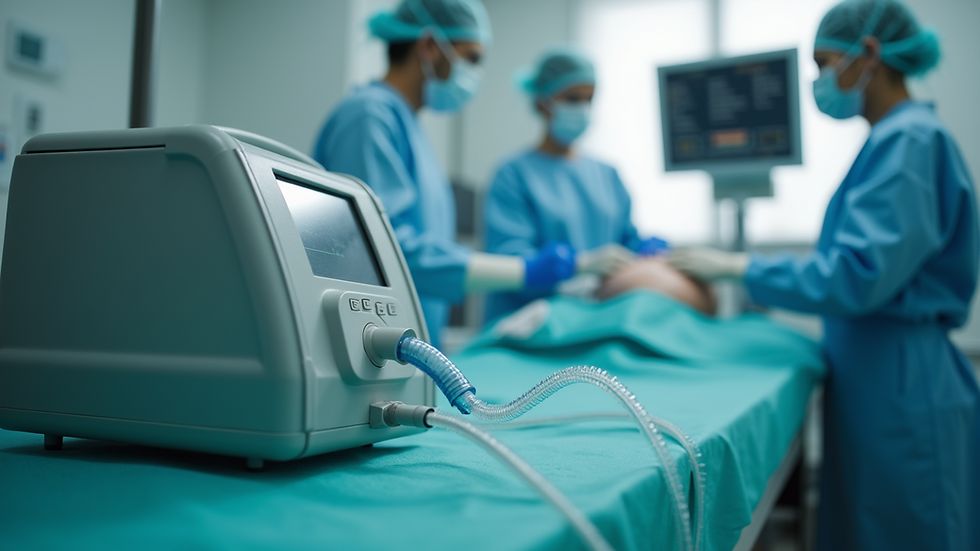Top Monitors for Healthcare Professionals
- kurejo
- May 11
- 3 min read
In the fast-paced world of healthcare, having the right tools can make all the difference. One of the most crucial tools for healthcare professionals is a reliable monitor. Whether you are a doctor, nurse, or technician, the right monitor can enhance your workflow, improve patient care, and reduce eye strain. In this blog post, we will explore the top monitors specifically designed for healthcare professionals.
Why Monitors Matter in Healthcare
Monitors are not just screens; they are essential for displaying critical patient information, imaging, and data. A good monitor can help healthcare professionals make quick decisions, leading to better patient outcomes.
Here are some reasons why monitors are vital in healthcare:
Clarity: High-resolution displays provide clear images, which are crucial for diagnostics.
Size: Larger screens allow for better visibility of multiple data points at once.
Color Accuracy: Accurate color representation is essential for imaging tasks, such as radiology.
Ergonomics: Monitors designed for healthcare can reduce eye strain and improve comfort during long hours of work.
With these factors in mind, let’s dive into some of the best monitors available for healthcare professionals.
1. Dell UltraSharp U2720Q
The Dell UltraSharp U2720Q is a 27-inch 4K monitor that offers stunning visuals and excellent color accuracy.
Key Features:
Resolution: 3840 x 2160 pixels for sharp images.
Color Coverage: 99% sRGB and 95% DCI-P3, making it ideal for color-critical tasks.
Connectivity: USB-C, HDMI, and DisplayPort options for versatile connections.
This monitor is perfect for radiologists and other professionals who need to view detailed images. Its ergonomic design allows for height, tilt, and swivel adjustments, ensuring comfort during long shifts.
2. BenQ PD3200U
The BenQ PD3200U is another excellent choice for healthcare professionals. This 32-inch 4K monitor is designed for designers and professionals who require precise color accuracy.
Key Features:
Resolution: 3840 x 2160 pixels for clear and detailed images.
Color Accuracy: 100% sRGB and Rec. 709 color spaces for accurate color reproduction.
KVM Switch: Allows you to control two computers with one set of keyboard and mouse.
The large screen size is beneficial for viewing multiple applications simultaneously, making it easier to manage patient data and imaging.
3. EIZO RadiForce RX850
For those in radiology, the EIZO RadiForce RX850 is a top-tier monitor. This 8-megapixel monitor is specifically designed for medical imaging.
Key Features:
Resolution: 3840 x 2160 pixels, providing exceptional detail.
Brightness: 500 cd/m², ensuring visibility in various lighting conditions.
Calibration: Built-in calibration sensor for consistent image quality.
This monitor is ideal for viewing X-rays, MRIs, and CT scans. Its high resolution and brightness make it a favorite among radiologists.
4. ASUS ProArt PA32UCX
The ASUS ProArt PA32UCX is a versatile monitor that combines high performance with excellent color accuracy.
Key Features:
Resolution: 3840 x 2160 pixels for stunning visuals.
HDR Support: Supports HDR-10 and Dolby Vision for enhanced contrast and color.
Connectivity: Thunderbolt 3, HDMI, and DisplayPort for flexible connections.
This monitor is suitable for various healthcare applications, from imaging to presentations. Its HDR capabilities make it stand out for those who need vibrant colors and deep contrasts.
5. Samsung CH890
The Samsung CH890 is a curved monitor that offers an immersive viewing experience.
Key Features:
Screen Size: 34 inches with a 21:9 aspect ratio for a wider field of view.
Resolution: 3440 x 1440 pixels for detailed images.
USB-C Connectivity: Simplifies connections and reduces cable clutter.
The curved design helps reduce eye strain, making it a great option for healthcare professionals who spend long hours in front of a screen.
Choosing the Right Monitor
When selecting a monitor for healthcare, consider the following factors:
Resolution: Higher resolution monitors provide clearer images, which are essential for diagnostics.
Size: Larger screens can display more information, making it easier to multitask.
Color Accuracy: Accurate color representation is crucial for imaging tasks.
Ergonomics: Look for monitors that offer height and tilt adjustments to reduce strain.
Connectivity: Ensure the monitor has the necessary ports for your devices.
Conclusion: Elevate Your Practice with the Right Monitor
Choosing the right monitor can significantly impact your efficiency and patient care in the healthcare field. With options like the Dell UltraSharp U2720Q and the EIZO RadiForce RX850, you can find a monitor that meets your specific needs.
Investing in a quality monitor is not just about having a good screen; it is about enhancing your workflow and improving patient outcomes. Take the time to evaluate your options and choose a monitor that will support you in your vital work.




Comments